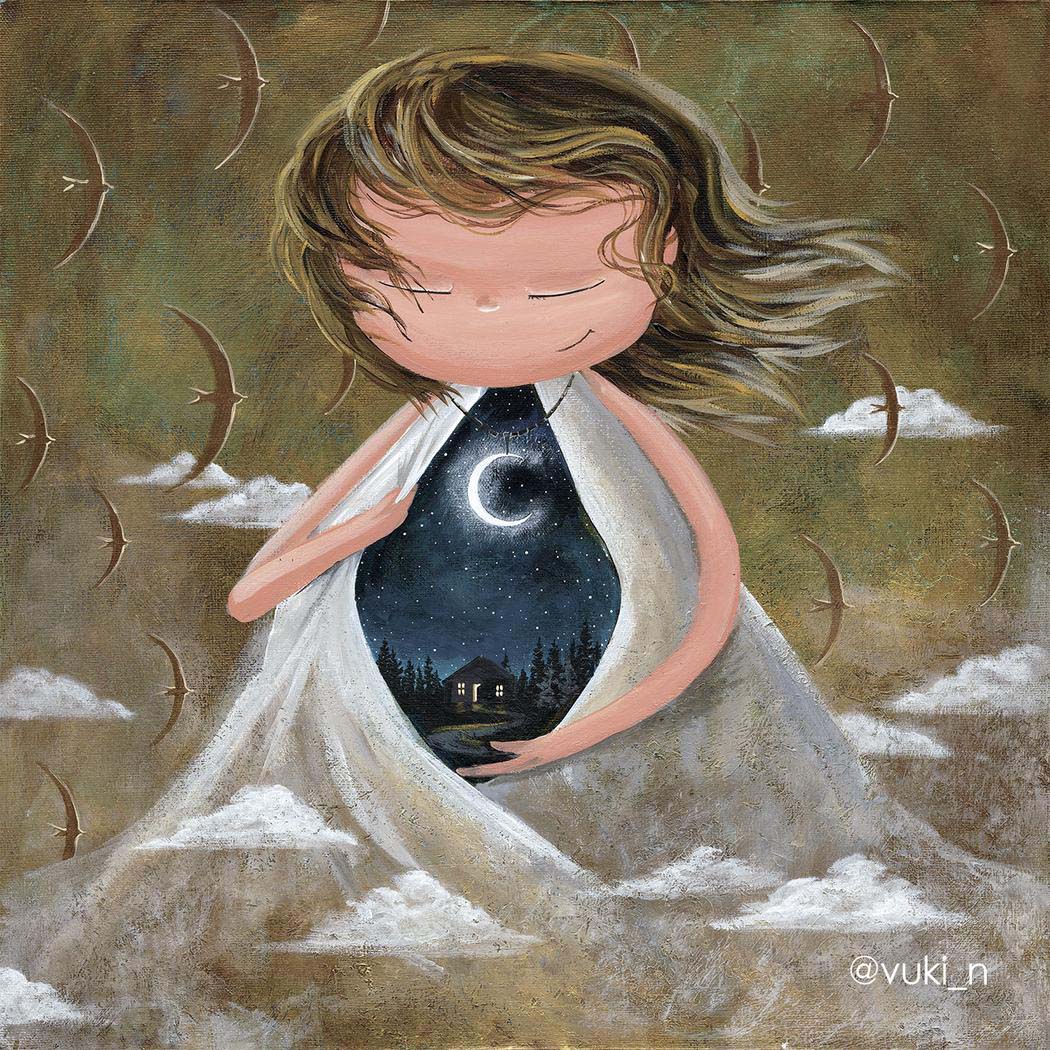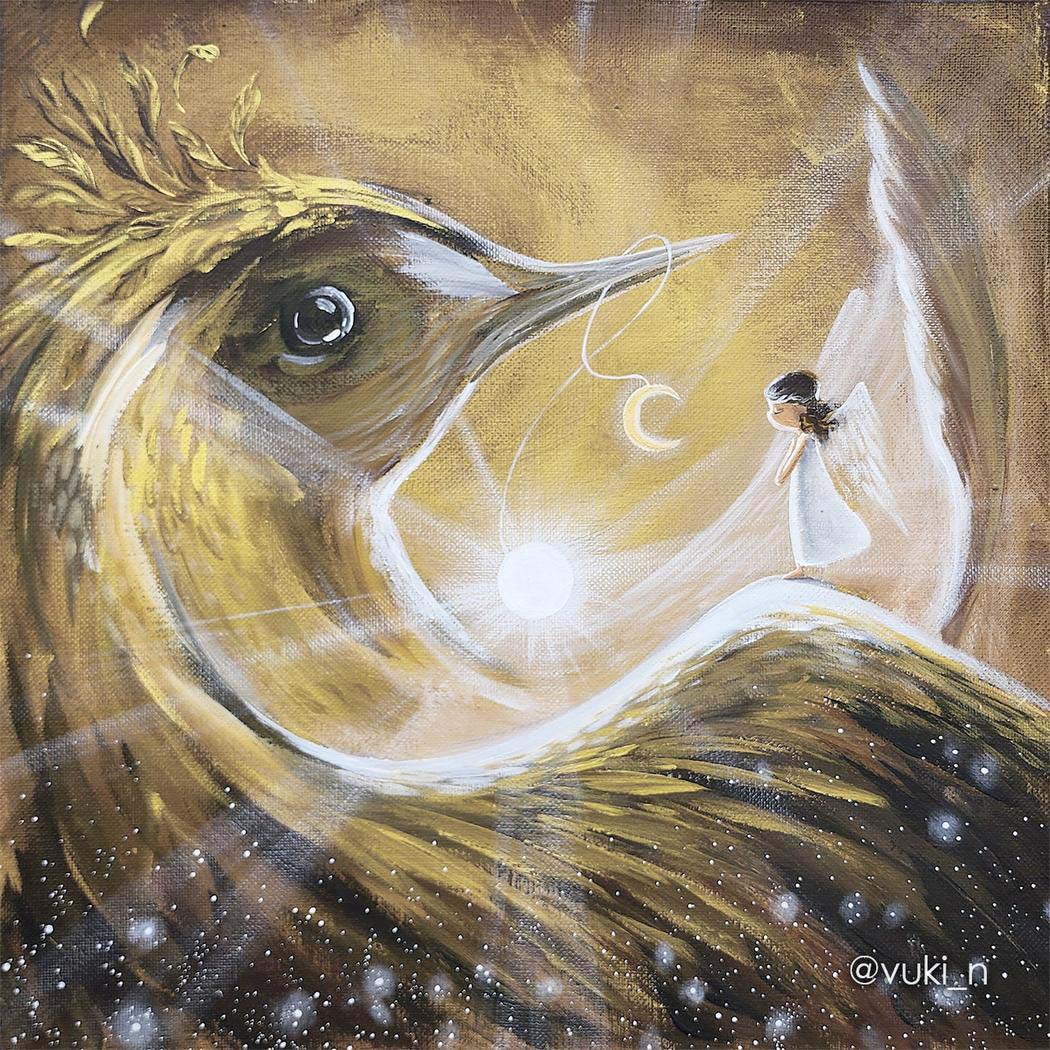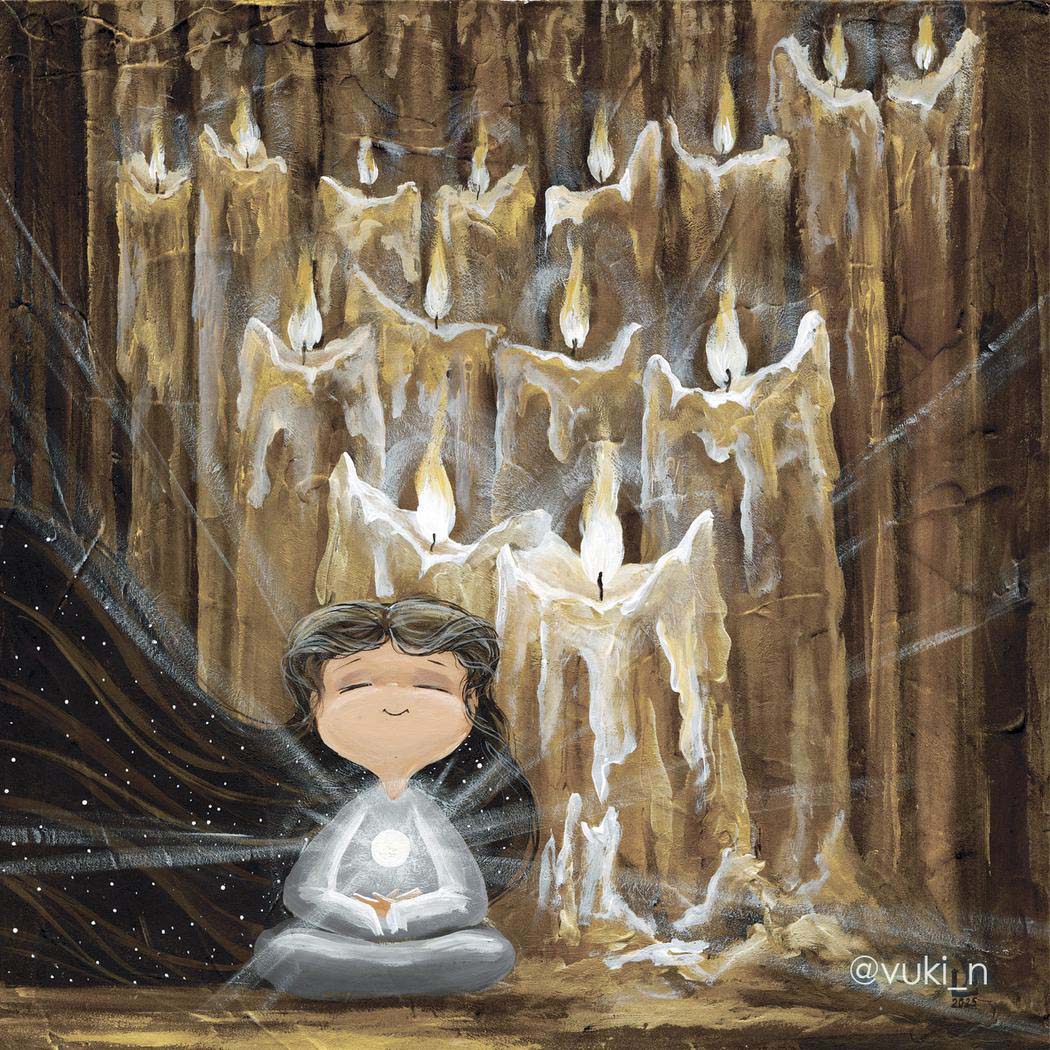Natalia Lukomskaya
Your education: MARKHI (Moscow Architectural Institute)
Describe your art in three words: Art of Open Heart
Your discipline: I specialize in contemporary, aesthetically appealing art with meaning. It is harmonious art that does not repel the viewer at the moment of encounter.
Website | Instagram
 Natalia Lukomskaya | The River of Life
Natalia Lukomskaya | The River of Life
How did your path in art begin, and what inspired you to create the project “About the Girl”?
My journey as an artist began with deep inner work. I was searching for a way to truly hear myself, to understand who I am and what genuinely resonates within me. Painting became a space where I could speak honestly—without filters or masks—and express myself exactly as I wished.
My artistic direction is what I call the “Art of Open Heart” — a philosophy and art movement that helps people look within themselves through images, paintings, and meanings. It’s about finding answers inside. That’s what makes my work unique. I don’t just aim to evoke an emotional response from viewers—when they come, say “Wow!” or “That’s beautiful,” feel touched or even cry. What matters to me is when they go beyond that, when they live through the experience and then move to the next stage—reflecting on why they felt what they did and discovering something meaningful within themselves.
The “About the Girl” series, of course, isn’t literally about a girl—it’s about me. Initially, it wasn’t a project meant for exhibition; I painted it for and about myself.
At that time, I was deeply immersed in studying Eric Berne’s Transactional Analysis—Parent, Adult, and Child. I realized that my inner child was suffering, and for me, the “About the Girl” series became a way to reach out and listen to him. The child state within us is responsible for joy, creativity, dreams—for a vivid perception of life, for feeling and savoring it. And it’s scientifically proven that in 96% of adults, the balance of these states is disrupted—they tend to underestimate the importance of their inner child.
This was my path toward transformation and acceptance of my inner child. But it turned out that these paintings resonated with other people too: through them, they reconnect with their own inner child and go through their own transformations.
The path to oneself is a deeply individual journey, so the series intentionally has no rigid structure. Only two works have a clearly defined place. The first one, “Self-Worth,” marks the beginning—the foundation, the crucial realization that I exist in this world, I am alive, and simply by living, I already have value. From that understanding, everything else begins. The last painting, “Transition” concludes the exhibition. It’s not an ending or a point—it’s a transition, the place where we move to the next level, and everything begins anew.
 Natalia Lukomskaya | The House Within
Natalia Lukomskaya | The House Within
You mention that art, psychology, and philosophy are interconnected in your work. How do these fields come together in your creative process?
My creation is an intertwining of philosophy and Art. Psychology stands close to philosophy — they’re so connected that people sometimes confuse the two. For me, these concepts are inseparable. Art is my language, and philosophy is the depth through which I understand inner processes.
Psychology examines these processes in detail, while philosophy is a reflection on the meaning of life.
When I create, I don’t just paint an “image.” I explore a state of being and ask myself: What do I feel? Why do I need this? What is it connected to?
In this way, each image becomes not merely visual but symbolic and multilayered.
It is precisely philosophy that helps me look inward and make sense of things — to seek answers for myself.
From this connection was born the direction I call “The Art of the Open Heart” — a space for an honest conversation with oneself through creativity.
My paintings, projects, and workshops are not about technique; they are about allowing a person to come into contact with their true self.
And everyone who engages with this art perceives something of their own in it — because deep meanings are always universal.
 Natalia Lukomskaya | The Breath of Autumn
Natalia Lukomskaya | The Breath of Autumn
The series contains 52 works. Why 52? Does this number have a special significance?
Yes, of course — for me, it’s not a random number. When I decided that I would create a series, it was important to me that it had a sense of a cycle. The entire series is about awareness and meaning. At that point, I already had 28 paintings, and I started thinking about what else could represent a complete cycle. And of course, for every person living on this planet, a year is a cycle. A year is that period during which everything happens — we live through it, and then the next turn begins. There are 52 weeks in a year.
In the series “About the Girl”, there are 52 works: our world develops cyclically, and in 52 weeks the Earth travels around the Sun — each time we face new challenges and experiences at a different level.
I created the “About the Girl” series, first and foremost, for myself. The focus was on my inner world and on me — and that’s why it resonated with others. There was an interesting moment when I had painted around 42 works and felt that I had run out of ideas, that I couldn’t come up with anything new. But then, quite miraculously, new paintings were born — ones that became some of the key pieces of the project: “Parents,” “Intuition and Choice,” and “My Home” appeared when I thought the series was already finished. After completing the series, I believe that an artist should not stop their creative flow — if images of the girl keep coming, I paint them. And if they stop, then I will stop. I don’t have a strict understanding that the series is finished and that I will no longer work in this direction. If new images come, there will be new paintings.
The “About the Girl” series is a choice of a conscious path — a journey of self-discovery and reconnection with one’s inner child. There’s a metaphor that an artist is a vessel: by working through personal and collective experiences, they transpose them onto the canvas, offering others the opportunity to see things from a new perspective.
Could you describe how you choose the themes for each painting?
Yes, that’s the most common question people ask: How do your images come to life? But the answer is rather vague, because some images appear in the very process of painting. Some paintings seem to create themselves. Or, for example, a certain phrase or image touches something inside me, and I live with it for a month or two — and only then does a painting emerge. So, there’s no clear answer to how it happens.
But if you think about it, first and foremost, it’s always a creative flow. Sometimes the paints dictate, sometimes the canvas, sometimes the image itself. Sometimes it’s a phrase that catches me, and a painting is born right there. The first thing is always the impulse.
In the “About the Girl” series, each story is not only about me but also about that part within everyone who searches, feels, and learns to be themselves.
I am part of this world. I’m not that unique or special. That’s why my thoughts, ideas, and emotions often resonate with others — because, in truth, we’re moved by many of the same things, and we reflect on similar feelings.
If a theme resonates deeply with me, it will most likely resonate with others too. It’s important for me to remain honest and sensitive — first of all, with myself.
 Natalia Lukomskaya | The Bird of Life
Natalia Lukomskaya | The Bird of Life
Many of your works seem to lead viewers toward self-discovery and inner harmony. What role does self-knowledge play in your art?
Self-knowledge plays a primary role not only in my art, but in my life as a whole.
For me, the human journey is a constant search for meaning, awareness, and understanding. Why does this happen? Why do I act this way? Why is the world the way it is and not otherwise? Why do I find myself in certain situations? What are these situations meant to teach me? I always ask myself these questions.
I believe that art must be thoughtful. It should make a person not only say, “Ah, how beautiful!” or feel emotions, but also reach deep inner realizations. Perhaps this is the true responsibility of every artist — to consider what the viewer will take with them after encountering their art.
 Natalia Lukomskaya | The Light of the Ancestry
Natalia Lukomskaya | The Light of the Ancestry
In just five years, you reached an international level and became a member of the Japan Illustrators Association. What steps were most important on this journey?
Yes, at the moment my path in art has already been going on for seven years.
The main turning point was the realization that an artist cannot exist only for himself — an artist always creates for the viewer, and a viewer is essential.
If the world created an artist to create, it did not do so for them to hide what has been given to them.
And in fact, this is not only about artists — it applies to every person.
The most important step was, first of all, choosing myself — allowing myself to create in a way that is not accepted or expected within the traditional art community.
At that time, I faced a lot of negative feedback from art critics and gallerists who said that what I was creating was not art.
Then came participation in competitions, including international ones.
In 2020–2021, I took part in an international competition organized by the Japan Illustrators’ Association and won third place, which led to my acceptance into the Association.
 Natalia Lukomskaya | The Dance of Peace
Natalia Lukomskaya | The Dance of Peace
What advice would you give to emerging artists seeking to connect their inner world with their creative work?
The advice I would give, in general, to all artists is to try not to compare themselves to others, but to look for answers within themselves. What am I? What is truly mine? What resonates with me? When an artist deeply lives through what they create, the viewer feels it — and it never goes unnoticed.
Many contemporary artists and gallerists say that one must search for a new style, invent something original, stir emotions. But if an artist doesn’t aim to provoke emotions or chase a new style, and simply allows themselves to be… then, most likely, that’s exactly when they will create their own unique style — one unlike any other. And later, the right audience will come — those who will genuinely connect and empathize with what the artist creates.

Leave a Reply